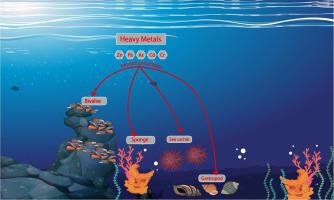当前位置:
X-MOL 学术
›
Mar. Pollut. Bull.
›
论文详情
Our official English website, www.x-mol.net, welcomes your feedback! (Note: you will need to create a separate account there.)
Heavy metal accumulation analysis using bivalve, sponge, sea urchin, and gastropod species as bioindicators
Marine Pollution Bulletin ( IF 5.8 ) Pub Date : 2024-04-24 , DOI: 10.1016/j.marpolbul.2024.116374 D. Vidyalakshmi , Aneena Yesudas , Gopika Sivan , E. Akhil Prakash , P. Priyaja
Marine Pollution Bulletin ( IF 5.8 ) Pub Date : 2024-04-24 , DOI: 10.1016/j.marpolbul.2024.116374 D. Vidyalakshmi , Aneena Yesudas , Gopika Sivan , E. Akhil Prakash , P. Priyaja

|
A comparative assessment of heavy metal accumulation potential in four distinct marine benthic bioindicators: the bivalve , the sponge , the sea urchin , and the gastropod were conducted. These organisms were collected from the same location, and the concentration of ten heavy metals was analyzed in water, sediment and various body parts of the organisms. The bioaccumulation potential was evaluated using the bio-water accumulation factor and bio-sediment accumulation factor. There was significant variation in the bioaccumulation potential of each organism with respect to different metals. The sponge proved to be a reliable indicator of Cd with a highest concentration of 2.60 μg/g. Sea urchin accumulated high concentrations of Cr (16.98 μg/g) and Pb (4.80 μg/g), whereas Cu was predominant (21.05 μg/g) in gastropod, followed by bivalve (17.67 μg/g). The concentration of metals in hard parts was found to be lower than in the tissues.
中文翻译:

使用双壳类、海绵、海胆和腹足类作为生物指示剂进行重金属积累分析
对双壳类、海绵、海胆和腹足类四种不同海洋底栖生物指示剂的重金属积累潜力进行了比较评估。从同一地点收集这些生物体,并分析了水、沉积物和生物体各个部位中十种重金属的浓度。使用生物水积累因子和生物沉积物积累因子来评估生物累积潜力。每种生物体对不同金属的生物累积潜力存在显着差异。该海绵被证明是镉的可靠指示剂,最高浓度为 2.60 μg/g。海胆积累了高浓度的 Cr (16.98 μg/g) 和 Pb (4.80 μg/g),而腹足动物中的 Cu 含量最多 (21.05 μg/g),其次是双壳类 (17.67 μg/g)。发现硬质部分中的金属浓度低于组织中的金属浓度。
更新日期:2024-04-24
中文翻译:

使用双壳类、海绵、海胆和腹足类作为生物指示剂进行重金属积累分析
对双壳类、海绵、海胆和腹足类四种不同海洋底栖生物指示剂的重金属积累潜力进行了比较评估。从同一地点收集这些生物体,并分析了水、沉积物和生物体各个部位中十种重金属的浓度。使用生物水积累因子和生物沉积物积累因子来评估生物累积潜力。每种生物体对不同金属的生物累积潜力存在显着差异。该海绵被证明是镉的可靠指示剂,最高浓度为 2.60 μg/g。海胆积累了高浓度的 Cr (16.98 μg/g) 和 Pb (4.80 μg/g),而腹足动物中的 Cu 含量最多 (21.05 μg/g),其次是双壳类 (17.67 μg/g)。发现硬质部分中的金属浓度低于组织中的金属浓度。



























 京公网安备 11010802027423号
京公网安备 11010802027423号